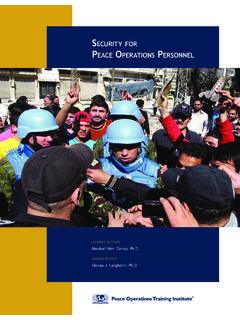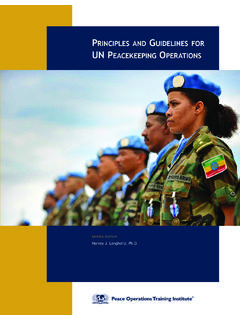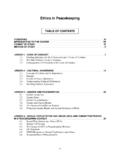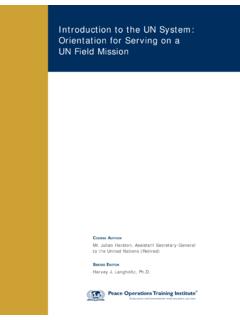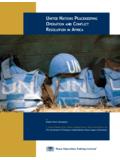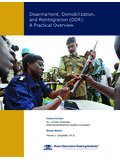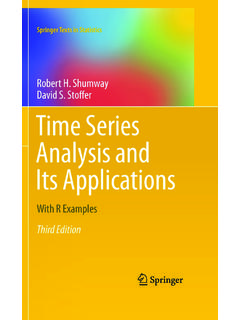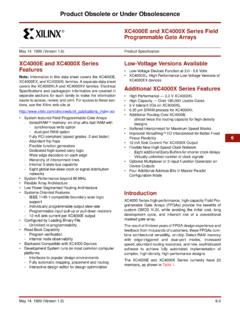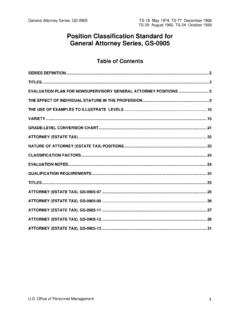Transcription of COURSE AUTHORS SERIES EDITOR - Peace Operations …
1 Mine Action and Explosive Hazard Management: Humanitarian Impact, Technical Aspects, and Global Initiatives C O U R S E AU T H O R S. The United Nations Mine Action Service The Geneva International Centre for Humanitarian Demining S E R I E S E D I TO R. Harvey J. Langholtz, Peace Operations Training Institute . Mine Action and Explosive Hazard Management: Humanitarian Impact, Technical Aspects, and Global Initiatives C O U R S E AU T H O R S. The United Nations Mine Action Service The Geneva International Centre for Humanitarian Demining S E R I E S E D I TO R. Harvey J. Langholtz, Peace Operations Training Institute . 2014 Peace Operations Training Institute Peace Operations Training Institute 1309 Jamestown Road, Suite 202. Williamsburg, VA 23185 USA. First edition: 2003. Revised: 2004, 2014. Cover: UN Photo #142640 by Martine Perret The Peace Operations Training Institute wishes to thank and acknowledge the vital contributions of the United Nations Mine Action Service and the Geneva International Centre for Humanitarian Demining, without whom this COURSE would not exist.
2 This COURSE has been developed for educational purposes, with a focus on humanitarian issues in mine action. The COURSE will not teach the student how to disarm an explosive or conduct fieldwork in mine and Explosive Remnant of War (ERW) affected regions. Students interested in this type of training should contact National Military Institutions, National Mine Action Authorities (NMAA) or local mine action representatives for information on formal instruction. For further information on mine related issues, contact the United Nations Mine Action Service (UNMAS): phone (212) 963-1234 or URL The material contained herein does not necessarily reflect the views of the Peace Operations Training Institute, the COURSE Author(s), or any United Nations organs or affiliated organizations. Although every effort has been made to verify the contents of this COURSE , the Peace Operations Training Institute and the COURSE Author(s) disclaim any and all responsibility for facts and opinions contained in the text, which have been assimilated largely from open media and other independent sources.
3 This COURSE was written to be a pedagogical and teaching document, consistent with existing UN policy and doctrine, but this COURSE does not establish or promulgate doctrine. Only officially vetted and approved UN documents may establish or promulgate UN. policy or doctrine. Information with diametrically opposing views is sometimes provided on given topics, in order to stimulate scholarly interest, and is in keeping with the norms of pure and free academic pursuit. Mine Action and Explosive Hazard Management: Humanitarian Impact, Technical Aspects, and Global Initiatives A NOTE FROM THE SERIES EDITOR .. 8. METHOD OF STUDY.. 9. LESSON 1: THE GLOBAL LANDMINE PROBLEM AND THE UNITED. NATIONS RESPONSE.. 12. : Global Overview.. 13. : Mine Action and Effective Coordination: The United Nations Policy .. 18. : The Strategy of the United Nations on Mine Action 2013-2018.
4 29. End-of-Lesson Quiz.. 46. LESSON 2: MINES, CLUSTER MUNITIONS, AND EXPLOSIVE REMNANTS. OF WAR: CONVENTIONS AND AGREEMENTS .. 50. : Mine Action Guidelines for Ceasefire and Peace Agreements.. 51. : The Anti-Personnel Mine Ban Treaty (Ottawa Convention) (MBT).. 56. : Certain Conventional Weapons (CCW) Amended Protocol II .. 68. : Certain Conventional Weapons (CCW) Protocol V .. 92. : Convention on Cluster Munitions.. 108. : Case Studies .. 126. End-of-Lesson Quiz.. 132. LESSON 3: LANDMINE AND ERW SAFETY TRAINING .. 136. : Introduction to Landmine and ERW Safety Training.. 137. : Basic Safety Principles in Mined and ERW-Affected Environments.. 139. : Identifying Landmines and Explosive Remnants of War (ERW).. 142. : Recognizing Dangerous Areas.. 147. : Emergency Procedures in a Mine Field.. 152. : Assisting a Mine/ERW Victim.
5 154. : Country-Specific Leaflets.. 155. End-of-Lesson Quiz.. 158. LESSON 4: INTERNATIONAL MINE ACTION STANDARDS (IMAS) AND. INTERNATIONAL AMMUNITION TECHNICAL GUIDELINES (IATG).. 162. : Guide for the Application of International Mine Action Standards .. 167. : Clearance Requirements.. 174. : Guide to the International Ammunition Technical Guidelines.. 177. End-of-Lesson Quiz.. 183. LESSON 5: VICTIM ASSISTANCE.. 188. : Introduction to Victim Assistance.. 189. : Victim Assistance Policy Document.. 190. End-of-Lesson Quiz.. 202. LESSON 6: MINE RISK EDUCATION.. 206. : Mine Risk Education (MRE).. 207. : International Mine Action Standards for Mine Risk Education: Best Practice Guidebooks.. 208. End-of-Lesson Quiz.. 229. LESSON 7: MINE ACTION INFORMATION.. 234. : Mine Action Assessment and Survey.. 235. : The Information Management System for Mine Action (IMSMA).
6 240. : E-MINE: UN Mine Action Gateway.. 242. End-of-Lesson Quiz.. 246. LESSON 8: IMPROVISED EXPLOSIVE DEVICES.. 250. : Introduction to Improvised Explosive Devices (IEDs).. 251. : IED-related Terms and Definitions.. 258. : Suggested Actions if Encountering an IED.. 260. End-of-Lesson Quiz.. 263. APPENDICES.. 266. Appendix A: Glossary .. 266. Appendix B: Websites for Mine-related Programmes .. 295. Appendix C: Use of Route Cards .. 296. Appendix D: Countries Participating in the Convention on Cluster Munitions (CCM).. 298. Appendix E: Report of the Secretary-General on Assistance in Mine Action .. 302. Appendix F: Ottawa Convention Signatories and States Parties .. 307. Appendix G: States Parties to the Convention on Conventional Weapons (CCW).. 312. Appendix H: List of UN Peacekeeping Operations .. 318. End-of- COURSE Exam Instructions.
7 321. A Note from the SERIES EDITOR Dear Student: I am pleased that you have enrolled in the Peace Operations Training Institute Mine Action and Explosive Hazard Management: Humanitarian Impact, Technical Aspects, and Global Initiatives COURSE . This COURSE has been made possible through the significant contributions of the UN Mine Action Service and the Geneva International Centre for Humanitarian Demining. In this COURSE , the student will be introduced to the global problem of landmines and explosive hazard management and the ways in which international organizations are approaching the problem. The topics to be studied here include the guidelines for ceasefires and Peace agreements; the Anti-Personnel Mine Ban Treaty (Ottawa MBT); the convention on Cluster Munitions and Certain Conventional Weapons (Amended protocol II and Protocol V); landmine and UXO safety training; identifying landmines and UXOs; International Mine Action Standards (IMAS) and International Ammunition technical Guidelines (IATG) and guidelines for application; victim assistance; International Standards for Mine Risk Education; Mine Action Information.
8 And an introduction to Improvised Explosive Device (IED) awareness. The global problem of landmines and Explosive Remnants of War (ERW) has received considerable attention in the press and in public awareness. This attention is deserved because of the nature of the problem. Landmines and ERW are indiscriminate killers. When they are left behind following a conflict, they remain a threat to humanitarian workers, civilians, and all who toil to bring a nation out of war and back to self-sufficiency. Fields cannot be tilled, roads cannot be travelled, and crops cannot be brought to market until these items have been cleared. Often it is children and the poor who encounter mines while they go about their innocent lives. At a minimum, these explosions maim their lower extremities but often cause much greater devastation, including death.
9 Even when the hostilities of war are long past, these devices represent a lingering cruelty and an obstacle to recovery. It is this issue and this cruelty that the AUTHORS of this COURSE and others seek to confront. By studying this COURSE , the student will see what measures organizations and the international community are taking to address the disposal of landmines and explosive remnants of war. The student will also learn what contributions remain to be made. Harvey Langholtz Executive Director, Peace Operations Training Institute 8 | P E A C E O P E R AT I O N S T R A I N I N G I N S T I T U T E. Method of Study The following are suggestions for how to proceed with this COURSE . Though the student may have alternate approaches that are effective, the following hints have worked for many. Before you begin actual studies, first browse When you finish a lesson, take the through the overall COURSE material.
10 Notice the End-of-Lesson Quiz. For any errors, return to lesson outlines, which give you an idea of what the corresponding lesson section and re-read it. will be involved as you proceed. Before you go on, be aware of the discrepancy in your understanding that led to the error. The material should be logical and straightforward. Instead of memorizing After you complete all of the lessons, take time individual details, strive to understand concepts to review the main points of each lesson. Then, and overall perspectives in regard to the United while the material is fresh in your mind, take the Nations system. End-of- COURSE Examination in one sitting. Set up guidelines regarding how you want to Your exam will be scored, and if you achieve schedule your time. a passing grade of 75 per cent or higher, you will be awarded a Certificate of Completion.
